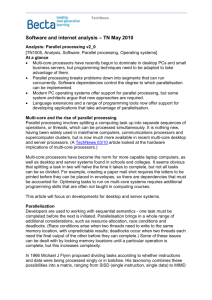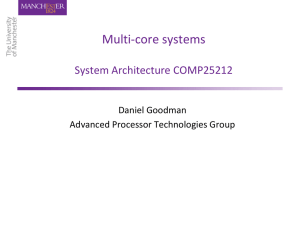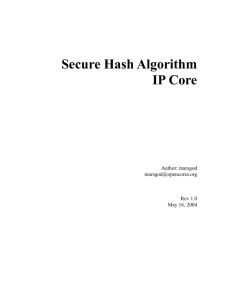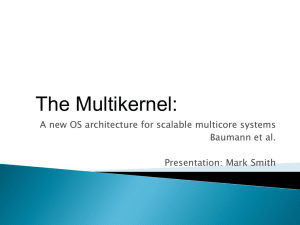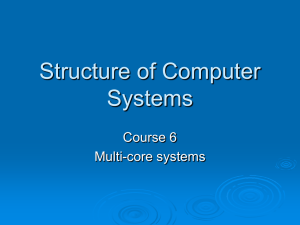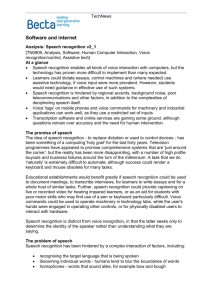HW Analysis: Multi-core processors v2_0
advertisement
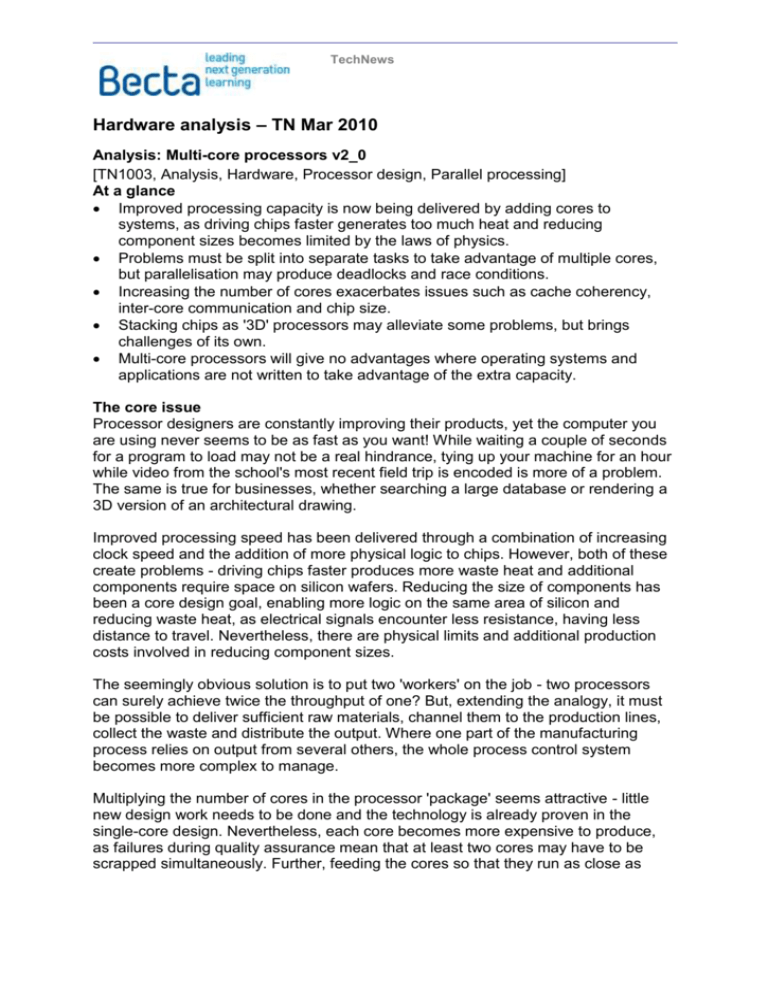
TechNews Hardware analysis – TN Mar 2010 Analysis: Multi-core processors v2_0 [TN1003, Analysis, Hardware, Processor design, Parallel processing] At a glance Improved processing capacity is now being delivered by adding cores to systems, as driving chips faster generates too much heat and reducing component sizes becomes limited by the laws of physics. Problems must be split into separate tasks to take advantage of multiple cores, but parallelisation may produce deadlocks and race conditions. Increasing the number of cores exacerbates issues such as cache coherency, inter-core communication and chip size. Stacking chips as '3D' processors may alleviate some problems, but brings challenges of its own. Multi-core processors will give no advantages where operating systems and applications are not written to take advantage of the extra capacity. The core issue Processor designers are constantly improving their products, yet the computer you are using never seems to be as fast as you want! While waiting a couple of seconds for a program to load may not be a real hindrance, tying up your machine for an hour while video from the school's most recent field trip is encoded is more of a problem. The same is true for businesses, whether searching a large database or rendering a 3D version of an architectural drawing. Improved processing speed has been delivered through a combination of increasing clock speed and the addition of more physical logic to chips. However, both of these create problems - driving chips faster produces more waste heat and additional components require space on silicon wafers. Reducing the size of components has been a core design goal, enabling more logic on the same area of silicon and reducing waste heat, as electrical signals encounter less resistance, having less distance to travel. Nevertheless, there are physical limits and additional production costs involved in reducing component sizes. The seemingly obvious solution is to put two 'workers' on the job - two processors can surely achieve twice the throughput of one? But, extending the analogy, it must be possible to deliver sufficient raw materials, channel them to the production lines, collect the waste and distribute the output. Where one part of the manufacturing process relies on output from several others, the whole process control system becomes more complex to manage. Multiplying the number of cores in the processor 'package' seems attractive - little new design work needs to be done and the technology is already proven in the single-core design. Nevertheless, each core becomes more expensive to produce, as failures during quality assurance mean that at least two cores may have to be scrapped simultaneously. Further, feeding the cores so that they run as close as Becta | TechNews possible to maximum capacity is no simple task - algorithms must be developed that manage shared resources and split jobs into separate components. The race for cores Tasks in servers are often duplicated or readily run in parallel, allowing programmers to reap the benefits of splitting processes between cores. All the major manufacturers have multi-core server products. For example, IBM's recently released POWER7 has eight cores, AMD's next generation of Opteron will come in both 8 and 12-core versions and Intel's forthcoming Nehalem EX processors will contain up to eight cores. Multi-core competition has also come to the desktop, with Intel promising six cores in its Core i7- 980X Extreme Edition (focused on gamers) and AMD expected to release competing products soon after. This proliferation of cores is extending 'down' through notebook and netbooks, and is expected to arrive soon in smartphones - PC Advisor suggested that quad-core ARM processors will be shipped during 2011. Following another course Building fast computers from multiple processors is nothing new, as many generations of 'supercomputers' demonstrate. The Cray Jaguar - which is the world's fastest - has been upgraded to contain nearly a quarter of a million cores. Such machines are used for tasks like nuclear research and climate modelling that require the same calculations to be processed across many data points. Telecommunications systems also have a requirement for high throughput parallel processing structures, to route millions of packets and to de-multiplex combined data streams carried by optical fibres. Hardware from companies like Alcatel and Cisco contains specialised embedded processors to perform these tasks, while Tilera is expects to launch a 100-core processor next year. Many graphics tasks can be split into highly parallel streams, but the graphics processing unit (GPU) often remains relatively idle. TechNews 09/08 discussed use of GPUs for completion of general computing tasks, such as analysis of data from oil exploration and searching for trends in retail data. Grid computing (TechNews 09/09) takes a different approach, breaking problems into discrete 'work units' that are independent of other tasks. These units can be allocated to computing centres with unused capacity or parcelled out to consumers willing to 'donate' spare processor time. On-going projects include research into cosmology, pharmacology and climatology. Hardware parallelism Tasks like rendering graphics are sometimes referred to as 'embarrassingly parallel', as it takes little effort to divide the problem into discrete components. The situation becomes more complex when one process requires resources used by, or the results from another process. Memory locking is generally implemented to prevent problems such as: © Becta 2009 http://emergingtechnologies.becta.org.uk Month/year page 2 of 5 Becta | TechNews Race conditions. Two processes generate results to be stored at a given location, so the content at that address will depend on which process 'wins'. Deadlocks. Two processes produce interim results that are required for the other to be completed, such that neither can progress. Due to the (relatively) slow speed of communicating with main memory, portions are kept in cache, 'nearer' to the cores. However, as each core generally has its own 'level 1' cache, this raises questions of coherency - if cache is a copy of portions of the main memory, then it must be consistent across all the caches in the system. These problems increase dramatically with the addition of new cores. One response to this is to implement transactional memory. Processor operations generate memory transactions, in a similar way to multiple operators manipulating the contents of a database. Although not widely used, this may be a solution that grows in importance. The number of cores significantly affects the amount of traffic across chip interconnects, since coordinating a shared workload requires constant 'snoops' into cache elsewhere, control commands and so forth. A 16-core chip (TechNews 01/09) may only be as efficient as one with two cores, due to waiting for access to main memory and operations designed to ensure cache coherence. Intel's prototype 48-core 'Single-chip Cloud Computer' (TechNews 02/10) implements hardware routing, rather than a shared memory bus, in order to reduce contention on interconnects. Intel researchers (TechNews 11/09) are also analysing alternative on-chip networking topologies for many-core communication. However, routing comes at a cost, as each communication must be analysed and sent along the appropriate interconnect. Researchers from Georgia Tech in Atlanta found that, on a 12x12 core processor grid, routing operations could take 20 clock cycles, demonstrating a need for simpler routers. Building up Multiplying cores in the horizontal plane increases the physical area of silicon used and the distance between processors. This in turn introduces messaging delays and generates waste heat as communications travel further. One solution is to build 'up' - literally stacking cores on top of each other. 3D processors can be assembled from cores already proven to work, but all the cores must be interlinked in some way. Through silicon vias (TSVs) provide vertical communication channels anywhere the chip designer chooses, not just on the edge where it is relatively simple to add connections. Despite their advantages, 3D processor packages are more costly to build, due to additional manufacturing stages. Further, as they have less surface area, they are more difficult to cool - researchers in Lausanne (TechNews 12/09) are investigating the use of liquid cooling techniques to deal with heat dissipation. © Becta 2009 http://emergingtechnologies.becta.org.uk Month/year page 3 of 5 Becta | TechNews Way to go Multiplying the number of cores available seems the obvious route to improving processor efficiency. However, as we have seen, it raises many issues, including: Coherency of memory caches Increased distances between the more 'remote' cores Efficiency of on-chip communication networks Wastage during manufacture Complexity where 3D structures are implemented. One issue receiving little public attention has been the inherent randomness of multicore systems, such as varying distances between cores that happen to be chosen to process a task, the effects of heating within the processor and unpredictable radiative events. Engineers at University of Washington are seeking to model and reproduce such errors to help developers write robust code for multi-core environments. Hardware parallelism is not restricted to cores in a single 'package', but to processors in separate sockets on a motherboard and different nodes working on the same task in a distributed processing structure. Indeed, core architectures often allow for internal parallelism, with separate software threads being processed simultaneously. The issues raised in this article are common at nearly every level, although their relative importance will vary. Programming in a multi-core era presents its own challenges, not addressed in this article. Some tasks are readily divided into threads, while others are very demanding. Desktop operating systems have only recently brought support for multiple cores into the mainstream, but keeping each core operating at optimum efficiency remains problematic - just having a six-core gaming platform by no means results in games running six times as fast. Unless tasks (such as artificial intelligence, user communications, graphics modelling and so forth) are programmed to run independently, the game may show no speed increase at all. Collapsing multiple physical servers into just a few units running several virtual 'machines' has reduced hardware requirements and - where properly managed improved efficiency. However, with multi-core becoming the norm, a reverse trend of 'physicalisation' is emerging, with separate cores dedicated to each virtual machine. (This does not represent a return to dedicated servers - machines may be moved between cores as demand and efficiency dictate.) A specific issue to consider during software procurement is whether licenses are written on a 'per-core' basis. If installed on a single computer workstation, this may not arise, but it may be relevant for server-based tasks and complex applications (such as computer aided design). Multi-core is likely to be the processing paradigm for the medium term future. Its success will depend on the degree to which the opportunities and challenges © Becta 2009 http://emergingtechnologies.becta.org.uk Month/year page 4 of 5 Becta | TechNews presented can be met in order to deliver genuine performance and energy-efficiency gains. (1612 words) © Becta 2009 http://emergingtechnologies.becta.org.uk Month/year page 5 of 5
